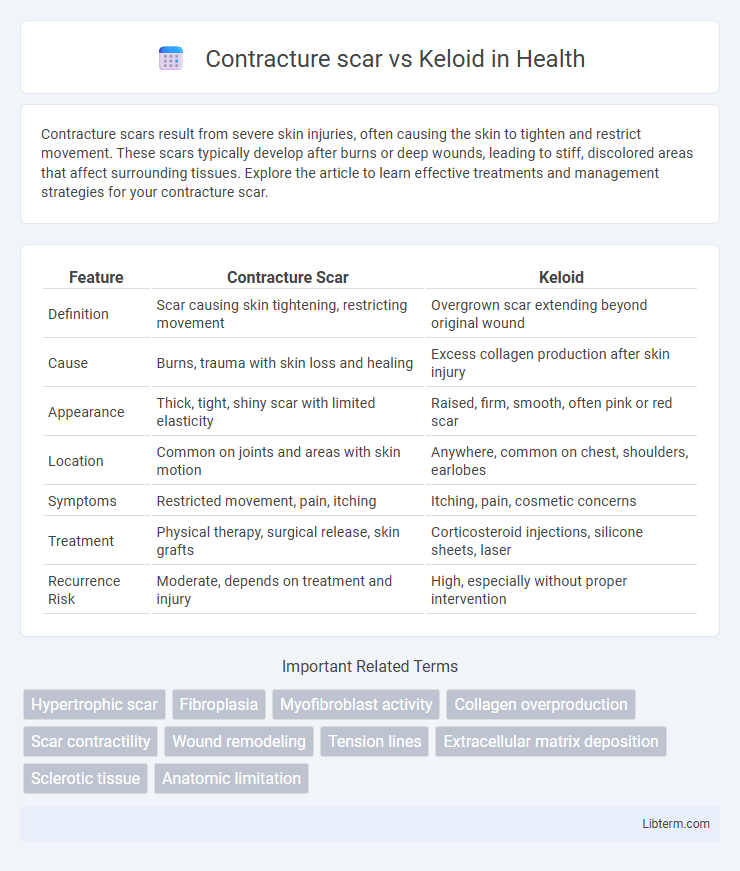Contracture scars result from severe skin injuries, often causing the skin to tighten and restrict movement. These scars typically develop after burns or deep wounds, leading to stiff, discolored areas that affect surrounding tissues. Explore the article to learn effective treatments and management strategies for your contracture scar.
Table of Comparison
| Feature | Contracture Scar | Keloid |
|---|---|---|
| Definition | Scar causing skin tightening, restricting movement | Overgrown scar extending beyond original wound |
| Cause | Burns, trauma with skin loss and healing | Excess collagen production after skin injury |
| Appearance | Thick, tight, shiny scar with limited elasticity | Raised, firm, smooth, often pink or red scar |
| Location | Common on joints and areas with skin motion | Anywhere, common on chest, shoulders, earlobes |
| Symptoms | Restricted movement, pain, itching | Itching, pain, cosmetic concerns |
| Treatment | Physical therapy, surgical release, skin grafts | Corticosteroid injections, silicone sheets, laser |
| Recurrence Risk | Moderate, depends on treatment and injury | High, especially without proper intervention |
Understanding Contracture Scars
Contracture scars result from extensive skin and tissue damage, often following burns, causing the skin to tighten and restrict movement due to collagen fiber contraction during healing. Unlike keloids, which are raised, thickened scar tissues that extend beyond the original wound, contracture scars primarily impair mobility by pulling the skin inward. Effective treatment aims to improve flexibility and prevent functional limitations through physical therapy, surgical release, or skin grafting.
What Are Keloid Scars?
Keloid scars are raised, thickened areas of skin that form due to an overproduction of collagen during the healing process, extending beyond the original wound boundaries. They often develop after injuries such as cuts, burns, or surgical incisions and can cause discomfort, itching, or cosmetic concerns. Unlike contracture scars, which primarily result from severe burns causing skin tightening and restriction of movement, keloids are benign growths that do not contract but can continue to grow over time.
Key Differences Between Contracture and Keloid Scars
Contracture scars result from skin tightening after burns, causing restricted movement and deformity, while keloid scars arise from excessive collagen deposition beyond the original wound boundaries, forming raised, thickened lesions. Contracture scars primarily affect skin elasticity and joint mobility, whereas keloids are more related to cosmetic concerns and may cause itching or pain. The treatment approaches differ, with contracture scars often requiring physical therapy or surgical release, and keloids managed through corticosteroid injections, laser therapy, or silicone sheets.
Causes of Contracture Scars
Contracture scars develop primarily due to the skin tightening over a large wound or burn, often resulting from prolonged inflammation and collagen overproduction during the healing process. These scars are caused by the contraction of underlying tissues, which restricts movement and leads to deformities, especially near joints. Unlike keloids, which result from excessive tissue growth beyond the wound boundary, contracture scars form as a response to tissue damage and fibrosis that limit skin elasticity.
Causes and Risk Factors for Keloid Scars
Keloid scars result from an overproduction of collagen during the healing process, often triggered by skin injuries such as cuts, burns, or piercings. Genetic predisposition significantly increases the risk of keloid formation, with higher incidence rates among individuals with darker skin tones, particularly those of African, Hispanic, or Asian descent. Other risk factors include age (common in people between 10 and 30 years old), prolonged wound healing, and areas of high skin tension like the shoulders and chest.
Clinical Appearance: Contracture vs. Keloid
Contracture scars present as tight, rigid, and often depressed areas of skin resulting from wound contraction, frequently limiting movement, especially near joints. Keloid scars appear as raised, thickened, and irregularly shaped growths that extend beyond the original wound boundaries. Unlike contracture scars, keloids are typically shiny and may continue to grow over time without causing functional impairment.
Diagnostic Approaches for Scar Types
Differentiating contracture scars from keloids relies heavily on clinical examination and patient history, with contracture scars often presenting as tightened, immobile skin over joints causing restricted movement, while keloids extend beyond the original wound margins as raised, thickened lesions. Diagnostic approaches include visual inspection, palpation, and possibly imaging studies such as ultrasound to assess scar depth and tissue involvement. Histopathological analysis remains essential for confirming diagnosis, showing dense collagen bundles in keloids versus thickened dermal fibrosis in contracture scars.
Treatment Options for Contracture Scars
Contracture scars are typically treated with surgical interventions such as Z-plasty and skin grafting to release tight, immobile tissue, improving mobility and function. Physical therapy and splinting are essential adjuncts to prevent re-contracture and maintain range of motion after surgery. Unlike keloids, contracture scars require treatments that focus on restoring tissue flexibility rather than solely reducing scar size or thickness.
Management and Treatment of Keloid Scars
Keloid scars require targeted management strategies including silicone gel sheets, corticosteroid injections, and laser therapy to reduce hypertrophic tissue growth. Surgical excision combined with postoperative radiation or pressure therapy effectively minimizes recurrence rates. Emerging treatments such as cryotherapy and intralesional 5-fluorouracil show promise in improving keloid scar resolution and patient outcomes.
Prevention Strategies for Scar Formation
Preventing contracture scars and keloids involves meticulous wound care and minimizing skin tension during healing. Use silicone gel sheets or pressure therapy to reduce hypertrophic and keloid scar formation, while maintaining proper hydration and avoiding infection supports healthy tissue regeneration. Early intervention with corticosteroid injections or laser therapy can further mitigate abnormal scar development and improve outcomes.
Contracture scar Infographic

 libterm.com
libterm.com